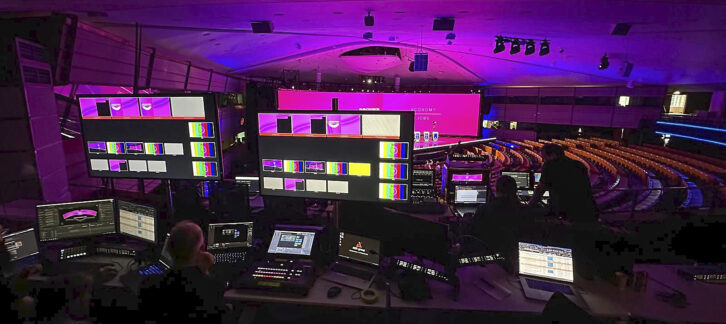Finally, preparations involved aspects such as provisioning sufficient 4G and 5G capacity, WiFi, cable internet, etc. For this, Proximus, a Belgian internet provider, was asked to temporarily install 4G and 5G antennas. Approximately 1,000 smartphones were used to transmit the footage to production hubs all around the world.
While some things, such as power generators and cooling units, haven’t changed over the last five years, the evolution in audio and video has been mindboggling. The transition to an IP-based backbone for audio, video and control signals, architected and installed in collaboration with Lawo, has had a major impact on operations.
The same is true of LED screens: for the 2024 election, traditional beamers were replaced with a giant (240m2), curved LED screen with a much crisper picture than ever before. Its deployment required special scaffolding, complete with 10 tons worth of counterweights, for a total weight of 35 tons for the entire construction.
Another change between 2019 and 2024 was the transition from copper wire to internet connections between the European Parliament and the European Broadcasting Union over the EBU’s LiveU setup. The Parliament owns several LiveU servers and uses them for all occasions where signals need to be shared, such as multiplex setups for the election debate prior to the 2024 election night.
The LiveU matrix for the debate event was configured by a Eurovision team that came to Brussels with a flightcase, set up a control room and connected its equipment to the Parliament’s infrastructure.
Approximately 90 per cent of all signals were sent using the broadcasters’ own LiveU services, over the venue’s network or the 4G/5G network. The remaining 10 per cent were transmitted via lines leased by the media. Although all broadcasters were expected to distribute their own signals, DG-Comm facilitated this process by channeling their signals to the master control room at the Belgian public broadcaster VRT, which acted as the EBU hub.
For the election night, DG-Comm filmed, produced and delivered its footage from a dedicated ad-hoc control room, in collaboration with an external director hired for the occasion, and with in-house staff.
On-site media crews were welcome to connect to the wall boxes scattered across the building, allowing all standup positions to view and use the available clean-feed content. “Thanks to our IP network, everybody had access to everything,” explains Francis Vanroelen, design and maintenance audiovisual engineer.
Given the high number of lines to be distributed to the world, the AV Unit had architected a system that leveraged the private IP lines between Brussels and Strasbourg as well as the link between the EBU (Geneva) and Strasbourg. This enabled DG-Comm to accommodate all media channels, while still enjoying enough wiggle room for last-minute changes or additions. The networked broadcast/AV setup resulted in just a handful of SNG trucks with satellite uplinks in Brussels.
Redundancy
Over the last few years, the Parliament has invested in core Lawo IP infrastructure, mainly for in-house and inter-campus signal distribution. The IP network is available in duplicate (“red” and “blue”) for redundancy, while an additional BNC network provides secondary baseband backup.

Election-night redundancy was deployed as follows: all audio and video essences were transported over the IP red and blue paths, with the most important signals additionally fed to the HD BNC network. This was because the Parliament’s AV Unit considers that a robust backup plan on an altogether different “island” remains indispensable in the event of a system hack or attack.
All signals shared with the media and outside destinations originated from a rented control room, which produced the content provided by the European Parliament. Those signals were converted to IP and shared via the Parliament’s network.
Being able to connect both the intercom and all Lawo mixing consoles to the IP network proved a major timesaver, making all signals accessible from anywhere. All signal routing and management of the IP core infrastructure was handled by Lawo’s VSM broadcast control system.
Nijssen and all internal members of the election taskforce team were very pleased with the result: “We managed to remind the world that the European Parliament really is the beating heart of the European Union,” he said.
“Without the wonderful teams that worked together like clockwork, it would have been impossible to deliver the 2024 election night. I want to thank everybody who contributed to the success of this event,” he added.
Source link : http://www.bing.com/news/apiclick.aspx?ref=FexRss&aid=&tid=6724abbef8dc43ac8378ee9b5d4112cd&url=https%3A%2F%2Fwww.tvbeurope.com%2Fip-migration%2Fcase-study-casting-a-vote-for-ip&c=16049072408077334916&mkt=en-us
Author :
Publish date : 2024-11-01 02:44:00
Copyright for syndicated content belongs to the linked Source.



